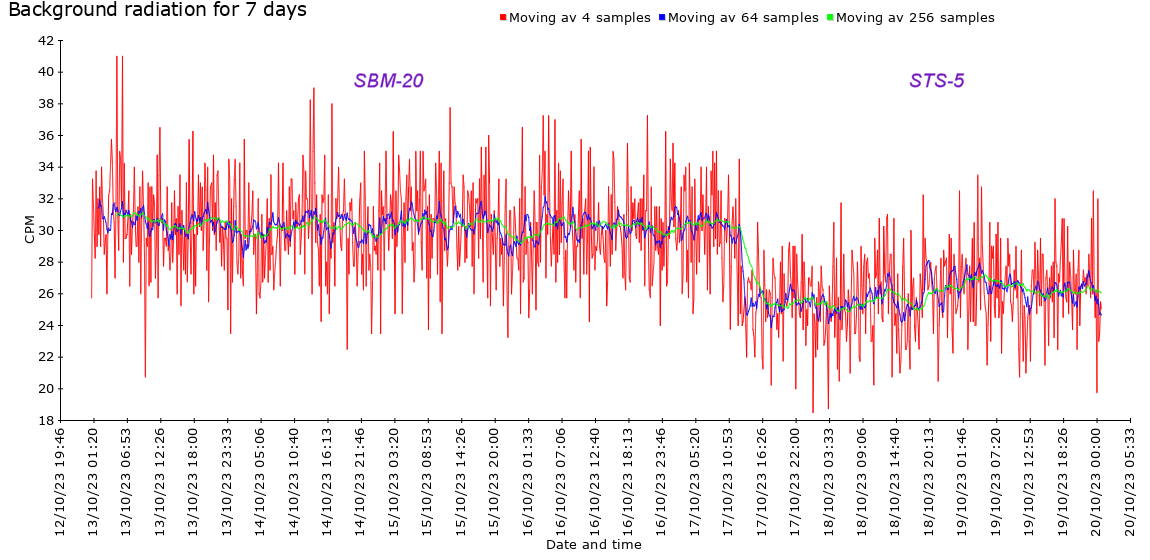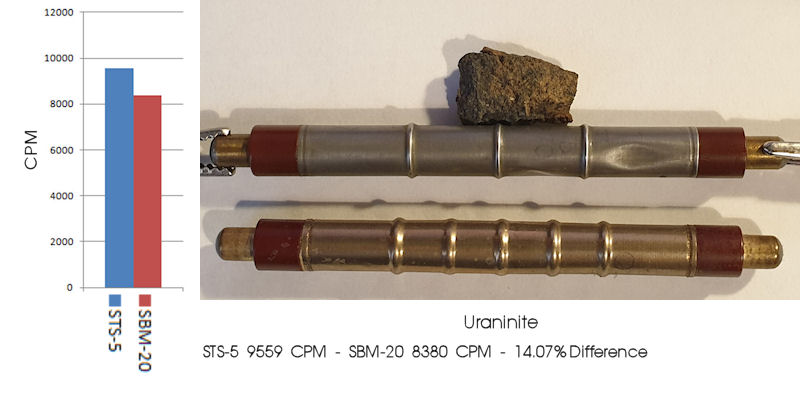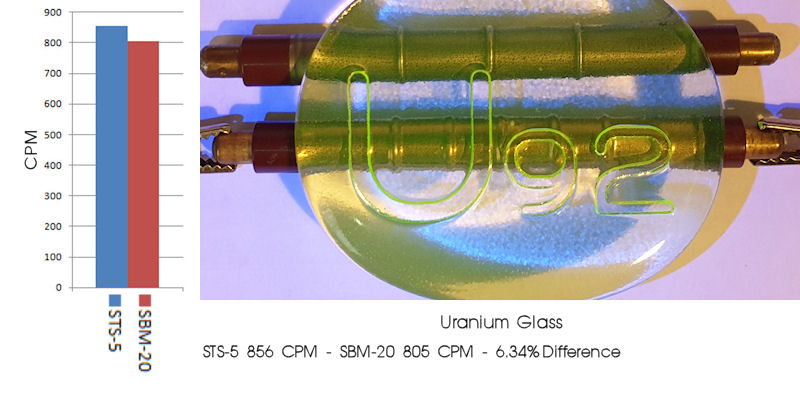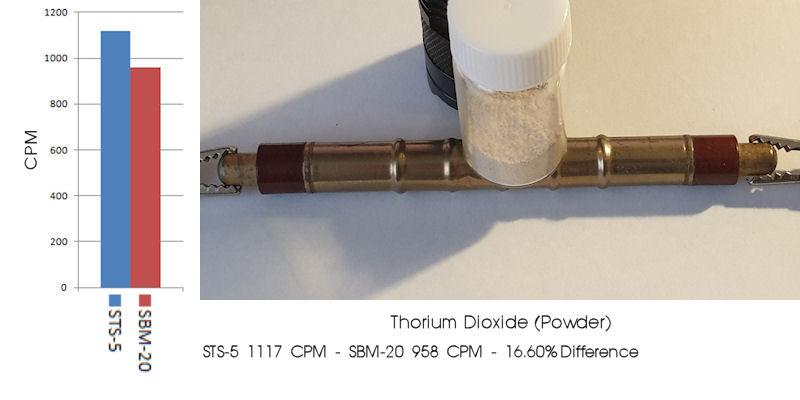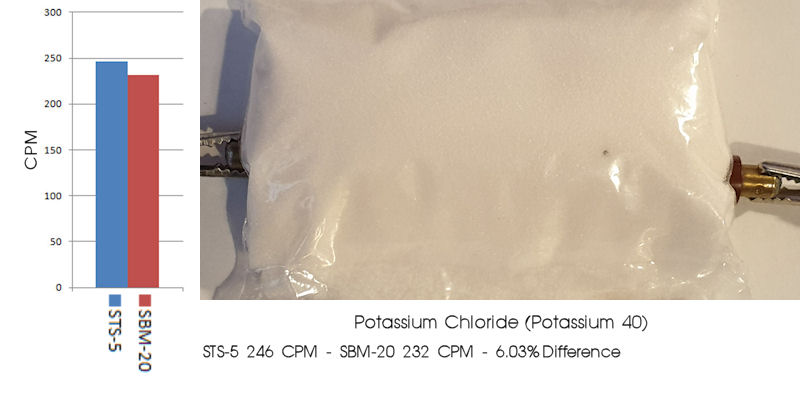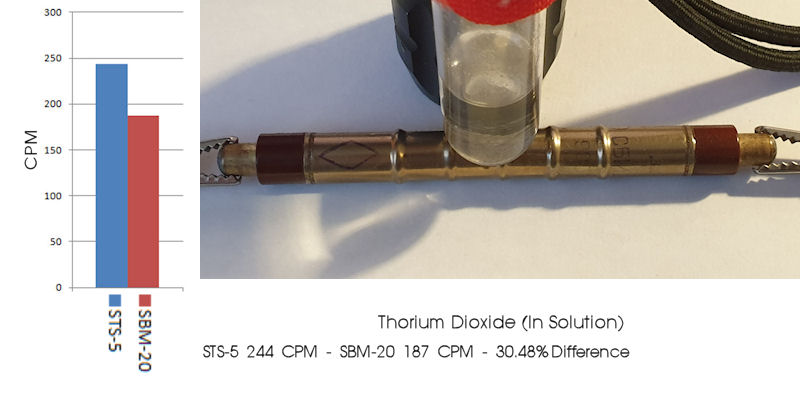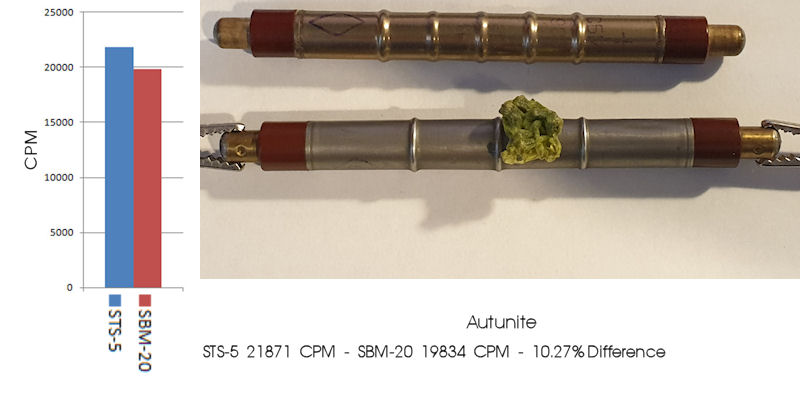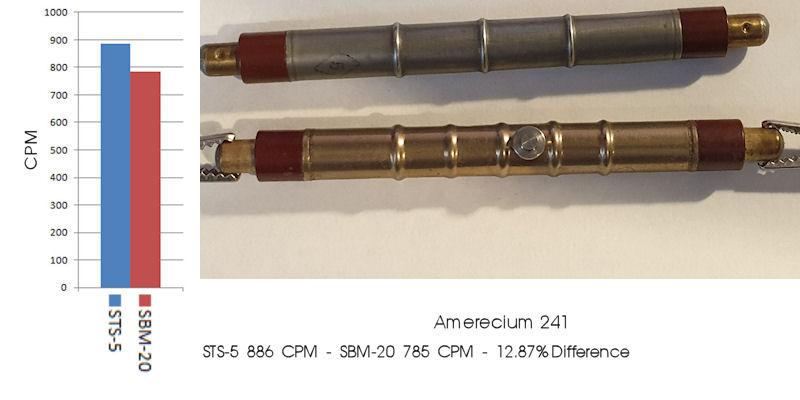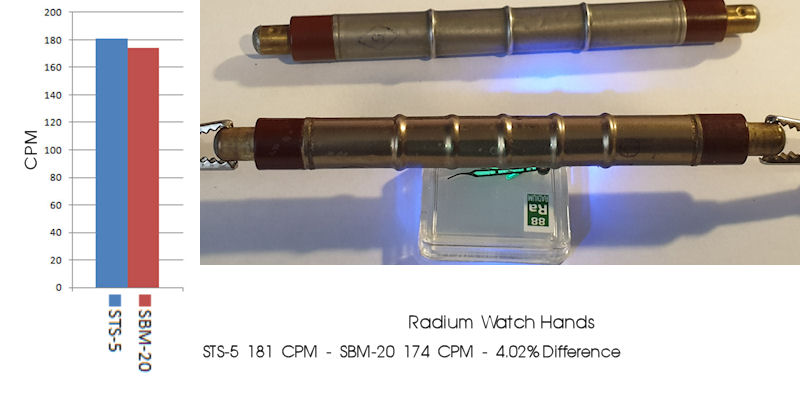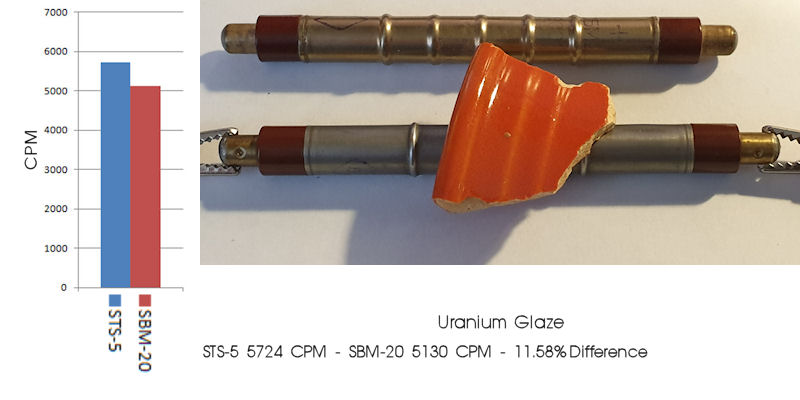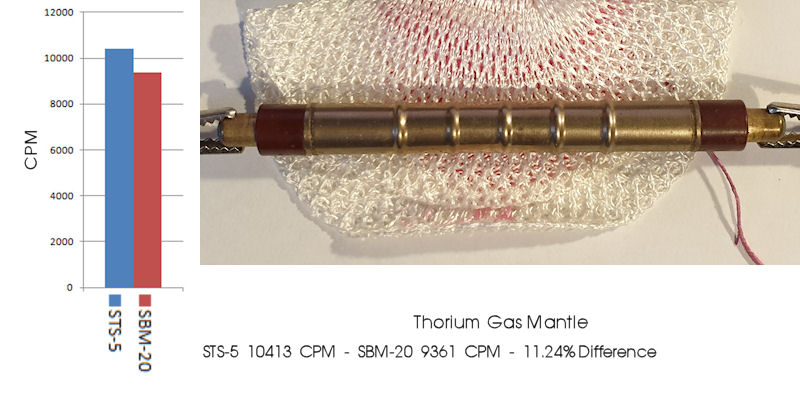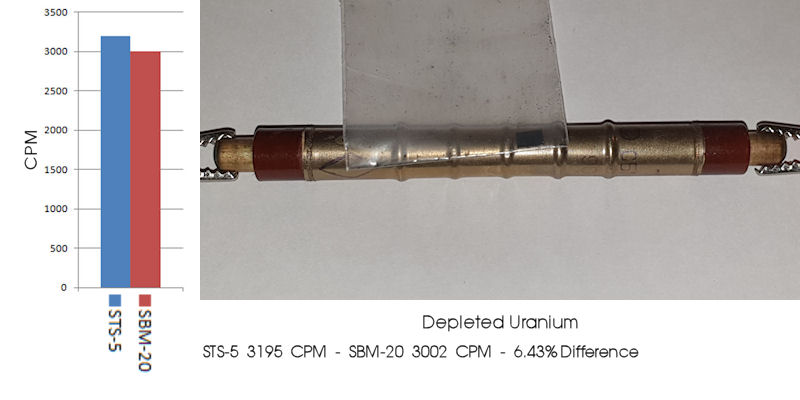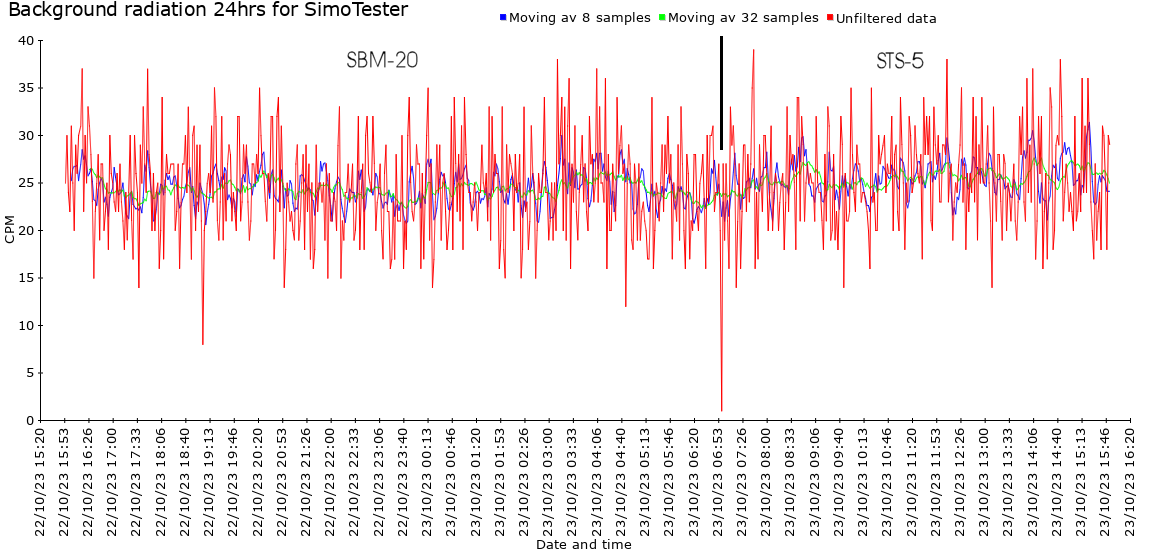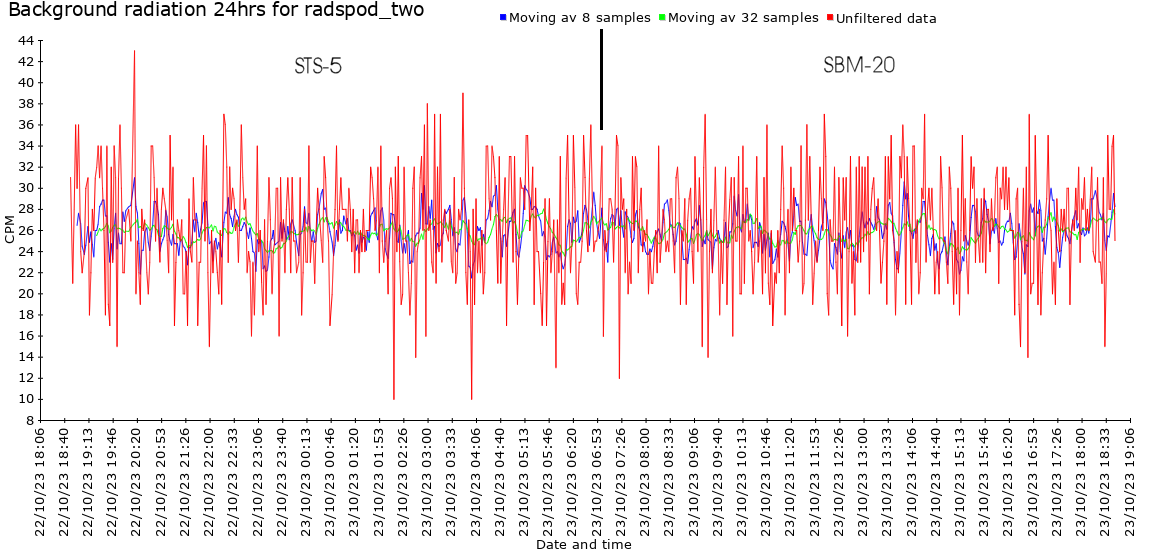- Forum
- Geiger counter discussions
- Geiger-Muller tubes
- SBM-20 and STS-5 (CTC-5) Sensitivity Comparison
SBM-20 and STS-5 (CTC-5) Sensitivity Comparison
2 years 1 month ago - 2 years 1 month ago #6758
by Simomax
SBM-20 and STS-5 (CTC-5) Sensitivity Comparison was created by Simomax
Attachments:
Last edit: 2 years 1 month ago by Simomax.
The following user(s) said Thank You: steadramon
Please Log in or Create an account to join the conversation.
2 years 1 month ago - 2 years 1 month ago #6762
by Simomax
Replied by Simomax on topic SBM-20 and STS-5 (CTC-5) Sensitivity Comparison
I took this a step further and compared the two tubes using 13 different sources. In hindsight I should have tested a J305 at the same time. It took a surprisingly long time, so I might set up some kind of testing jig and program an ESP to automate a lot of the task. I would also like to do tests at 1cm, 5cm and 10cm, so it would definitely need some kind of automation. I was actually a little surprised to see the STS-5 get a higher CPM for every source, yet the background is less for the STS-5.
Here are the results. There is also a PDF attached to download if you wish.
Here are the results. There is also a PDF attached to download if you wish.
Source STS-5 SBM-20 Difference
1 Uraninite 9559 8380 14.07%
2 Uranium Glass 856 805 6.34%
3 Uraninite with Gummite 2478 2301 7.69%
4 Thorium Dioxide (Powder) 1117 958 16.60%
5 Potassium Chloride 246 232 6.03%
6 Thorium Dioxide (In Solution) 244 187 30.48%
7 Autunite 21871 19834 10.27%
8 Amerecium 241 886 785 12.87%
9 Strontium 90 69219 64654 7.06%
10 Radium Watch Hands 181 174 4.02%
11 Uranium Glaze 5724 5130 11.58%
12 Thorium Gas Mantle 10413 9361 11.24%
13 Depleted Uranium 3195 3002 6.43%
Last edit: 2 years 1 month ago by Simomax.
The following user(s) said Thank You: Juzzie
Please Log in or Create an account to join the conversation.
2 years 1 month ago #6766
by Juzzie
Owner and operator of "southofhobart" monitoring stations.
Replied by Juzzie on topic SBM-20 and STS-5 (CTC-5) Sensitivity Comparison
Excellent!
I am wondering if you used the same HV source (geiger counter) for your sample tests as for your background comparison - could there have been a different voltage applied to the GM tubes for background test compared to the samle tests?
I am wondering if you used the same HV source (geiger counter) for your sample tests as for your background comparison - could there have been a different voltage applied to the GM tubes for background test compared to the samle tests?
Owner and operator of "southofhobart" monitoring stations.
Please Log in or Create an account to join the conversation.
2 years 1 month ago - 2 years 1 month ago #6769
by Simomax
Replied by Simomax on topic SBM-20 and STS-5 (CTC-5) Sensitivity Comparison
Actually, no. I did use different counters for the background and source testing. The background was from a GK Radmon, and the source testing was done with my breadboard counter, which is effectively a GK v5.5 (older version.) However, I have checked the voltages of both counters and both are correctly set at 390-400v. It wouldn't hurt to repeat the test though using the same counter as the source testing, so I have thrown a SBM-20 on it for a day or so, and then I will swap out to the STS-5 for a day or so. I also think it might be worth repeating the tests I have already done with some averaging - 1 minute, 5 minutes, 15 minutes and maybe 30 minutes. When I was testing the sources with both tubes, the way I decided the CPM was a little fluffy. I let it sit for just over a minute, waited until it peaked and fell, and then used the CPM reading of it's next peak. It might also be worth getting a good background reading for each tube to be tested so that can be subtracted from the resulting CPM to give a more accurate result. I think that might be necessary for doing testing over a distance of 5/10cm.
I am considering actually building some kind of test rig and specific code so semi-automated testing. That way I can just set it up and swap things then push a button and let the Arduino/MCU do it's stuff. I have a few less sensitive tubes (SI3BG/Dextray 3G8B/DOB-50/DOB-80. It would be nice to get some kind of sensitivity data on these too as well as the more common tubes.
I am considering actually building some kind of test rig and specific code so semi-automated testing. That way I can just set it up and swap things then push a button and let the Arduino/MCU do it's stuff. I have a few less sensitive tubes (SI3BG/Dextray 3G8B/DOB-50/DOB-80. It would be nice to get some kind of sensitivity data on these too as well as the more common tubes.
Last edit: 2 years 1 month ago by Simomax.
Please Log in or Create an account to join the conversation.
2 years 1 month ago #6773
by Simomax
Replied by Simomax on topic SBM-20 and STS-5 (CTC-5) Sensitivity Comparison
I have compared the STS-5 and SBM-20 again on the same counter I used with the sources. Interesting result.... Hardly any difference.
It does beg the question though; why on the first counter (GK Radmon Basic) is there such a difference, yet on the second counter (breadboard GK v5.5) there is hardly any difference. I have doubly checked the voltage on the breadboard counter and its reading 404v right now. STrange. I shall have to have a look at the GK Radmon and see why.....
It does beg the question though; why on the first counter (GK Radmon Basic) is there such a difference, yet on the second counter (breadboard GK v5.5) there is hardly any difference. I have doubly checked the voltage on the breadboard counter and its reading 404v right now. STrange. I shall have to have a look at the GK Radmon and see why.....
Attachments:
Please Log in or Create an account to join the conversation.
2 years 1 month ago #6776
by Simomax
Replied by Simomax on topic SBM-20 and STS-5 (CTC-5) Sensitivity Comparison
Okay... So the GK Radmon now is showing the same background for both tubes. The graph is from radspod_two. I just grabbed this graph, that's why the timing is off the other from SimoTester. It's currently sitting on a shelf in my office and I have been swapping the tubes from that. Radspod_two has SBM-20, breadboard counter has STS-5, then radspod_two has STS-5, breadboard counter gets SBM-20. There was obviously something amiss with the first background reading with both tubes. I know the voltage was high on the GK Radmon, but I can't remember when I changed it back down to 400v. It wasn't when I changed tubes... Or maybe. I dunno. Can't remember. Too many counters around me at the moment. I really do think a purpose built semi-automated system would be a good idea for this. Something that logs every few seconds, checks voltage, or at least logs it and does some decent averaging. It would be super neat if I could fabricobble some kind of carousel that held 3 or 4 tubes and automatically rotated the next tube into place and started recording. I'd have to work out some kind of switching arrangement for them, so only one tube was on at a time. I'm thinking some relays and a RC servo to rotate the carousel to line the relevant tube up with the source. Oooo, a linear bearing/shaft thing and a stepper motor would work well for moving the source back. So 1st check with source nearly touching the tube, then move back to 1cm, then 5 then 10cm. Each time recording the results, then when done it automatically moves on to the next tube and goes again. I would have minimal work to do then as I would just need to set the source at the first instance, then push a button and sit back and drink wine. Sounds like a plan!
Anyway, the graph from radspod_two, that shows no change in background between tubes, this time....
Anyway, the graph from radspod_two, that shows no change in background between tubes, this time....
Attachments:
Please Log in or Create an account to join the conversation.
Moderators: Gamma-Man
- Forum
- Geiger counter discussions
- Geiger-Muller tubes
- SBM-20 and STS-5 (CTC-5) Sensitivity Comparison
Time to create page: 0.269 seconds

